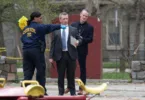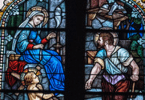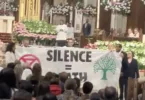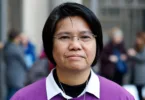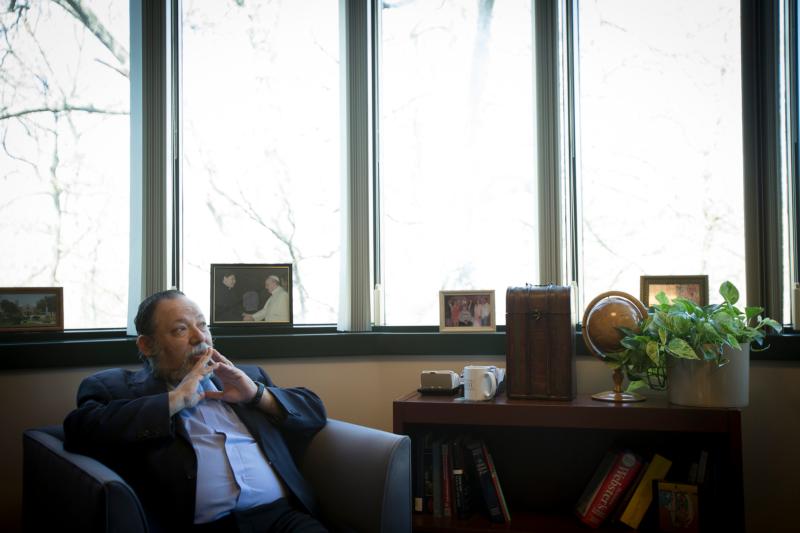
Father Carlo Maria Galli of Argentina is seen at the U.S. Conference of Catholic Bishops’ building in Washington April 6. He says if you want to know what Pope Francis considers important, the Aparecida document written by the bishops of Latin American and the Caribbean in 2007 is a good place to start. (CNS photo/Tyler Orsburn)
by Carol Zimmermann
WASHINGTON (CNS) — If you want to know what Pope Francis considers important, the Aparecida document written by the bishops of Latin American and the Caribbean in 2007, is a good place to start, according to an Argentine theologian.
The theologian, Father Carlos Maria Galli, helped collaborate on this document written by then-Cardinal Jorge Bergoglio of Buenos Aires, and has continued to discuss the role of the church with his then-archbishop, now Pope Francis.
When it was issued, the Aparecida document provided guidelines and a pastoral vision for the region’s church, which was experiencing a sharp decline in its Catholic population. But the document’s call for Catholics to be missionaries was hardly just a local message just for that time. It is something the pope continues to emphasize, Father Galli told Catholic News Service April 6.
The document was named for Brazil’s Shrine of Our Lady of Aparecida, where the bishops met for the Fifth General Conference of the Bishops of Latin America and the Caribbean.
The priest, dean of the theology faculty and director of doctoral studies at the Catholic University of Argentina, was in Washington in early April to speak at The Catholic University of America and the university’s seminary, Theological College. The talks were sponsored by the U.S. Conference of Catholic Bishops’ Subcommittee on the Church in Latin America, the Institute for Policy Research & Catholic Studies at Catholic University and the USCCB’s Committee on Cultural Diversity in the Church.
Safe to say, the priest knows Pope Francis more than your average theologian. He said he met the pope 40 years ago and has worked with him for about 30 years. Not only was the pope his archbishop in Argentina, but he was the chancellor at the university where Father Galli works. Currently, the priest is a member of the International Theological Commission, a group of theologians who serve as advisers to the pope.
The priest said the 2007 document by the Latin American bishops communicated the “full life of Christ” and was the essence of the pope’s message six years later in the apostolic exhortation, “Evangelii Gaudium” (“The Joy of the Gospel”) where he spoke of the church’s mission of evangelization in the modern world.
Aparecida’s message of church outreach, going out to the peripheries and meeting others where they are is central to what the pope aims to do in his writings and travels, Father Galli said, noting that the pope continually stresses that the “church must go where the others are.”
The pope’s notion of reaching out to others is “not to make them the way that I am” either, but is a whole culture of encounter, the priest added and is reflected in his writings and in what he says and does in his visits to other countries.
The pope’s visit to the United States was a clear example of that, he added, noting that his words spoke to people’s hearts. “That’s what we must do,” Father Galli said. “Be with others where they are” and make bridges between the church and other cultures.
During the pope’s visit to Brazil for World Youth Day in 2013, he celebrated Mass at the Shrine of Our Lady of Aparecida and after Mass he took a copy of the statue of Mary outside to bless the thousands of people who didn’t fit in the church.
The pope asked the crowd to pray for him, especially that he would be able to return to Aparecida in 2017 to celebrate the 300th anniversary of the statue’s discovery.
Father Galli told participants at his Catholic University lecture April 6 that the pope planned to visit Aparecida next year which also would be the 10th anniversary of the bishops’ document
The image of Our Lady of Aparecida is a dark wooden sculpture that was caught in the nets of three local fishermen in 1717. One of the men kept the statue in his home for 15 years; his neighbors, then people from farther away, came to consider it an object of devotion. A chapel was built to house the statue in 1734, and work on the first basilica began in 1834. In 1929, Pope Pius XI declared Our Lady of Aparecida the “queen and patron of Brazil.”

